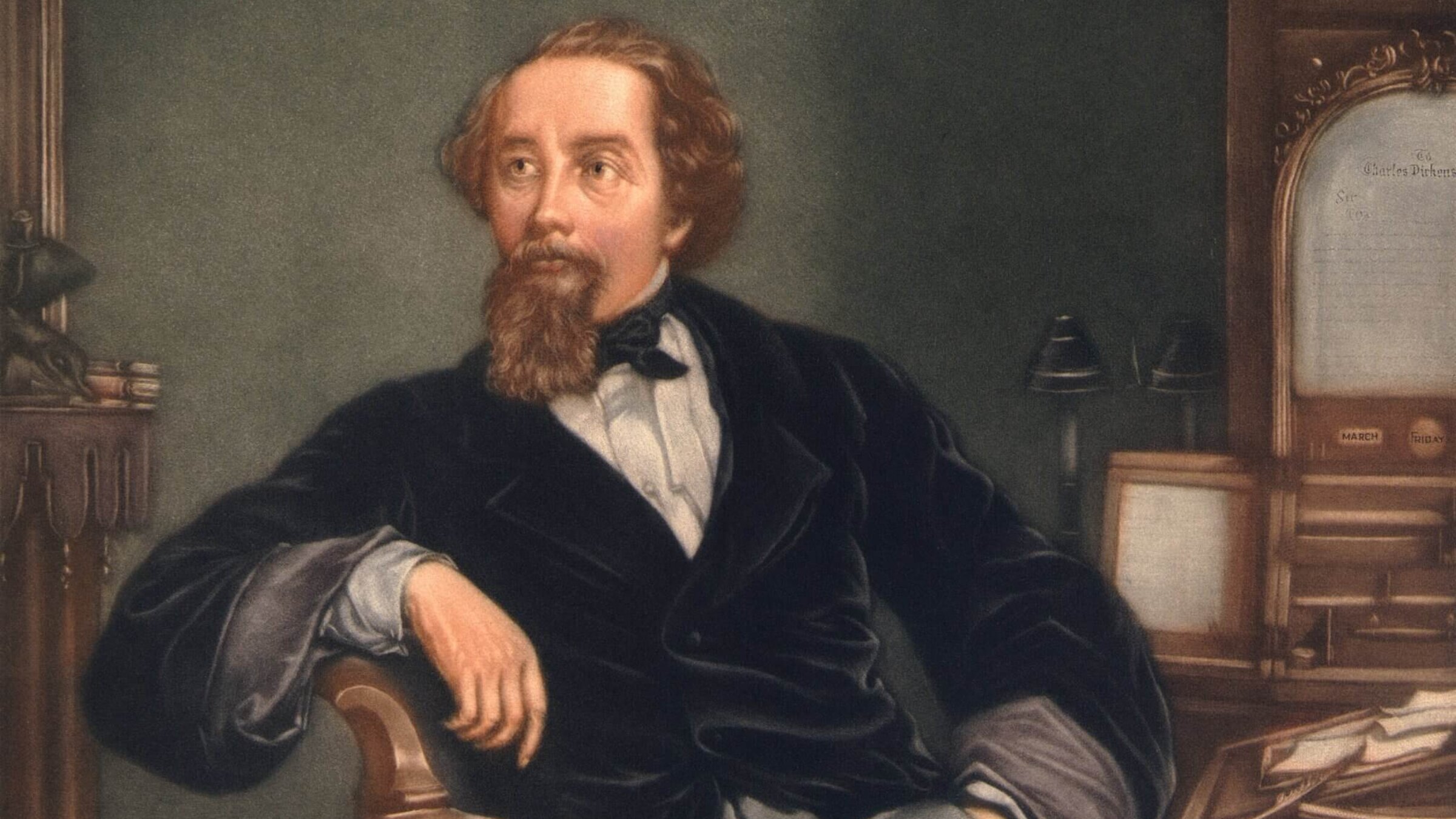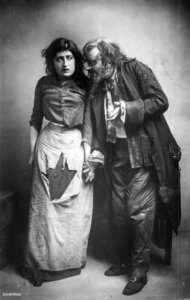So, what do we do with a monstrous, antisemitic man like Charles Dickens?
The case against the author goes far beyond one offensive character in ‘Oliver Twist’

Mr. Dickens at his writing desk. Photo by Getty Images
Who was the real villain of Oliver Twist — Fagin, introduced in the cast of characters as “a crafty old Jew, a receiver of stolen goods,” or the author Charles Dickens himself?
The question arose as I reread Dickens’ Oliver Twist, in advance of seeing New York’s City Center Encores production of Lionel Bart’s musical version based on the Dickens novel, Oliver!, starring Raúl Esparza as Fagin.
As it turned out, my argument with Dickens, I found in this rereading, was two-fold, not only as a Jew but as a woman.
My discomfort with Oliver Twist began when I first read it in junior high. Dickens had already become one of my favorite authors because of his masterpieces Great Expectations and A Tale of Two Cities. I had also learned the eminently hummable songs from the musical Oliver! by heart.
Then I met the original Fagin in the pages of the novel itself. The jolly songs that composer Lionel Bart (who was himself Jewish) gives Fagin to sing in the musical did not prepare me for the shock of the notorious antisemitic tropes Dickens himself used to describe him. Not then. Not now.
It is still astonishing to me that Dickens, the great social reformer renowned for standing on the side of the vulnerable and the poor, depicted Fagin using antisemitic stereptypes. I have read literary critics who defend Dickens by pointing out that Oliver Twist teems with many other memorable evil-doers and hypocrites, all of whom are Christian. Yes, but only Fagin is stigmatized as a Jew, repeatedly identified throughout the novel simply as “the Jew” in an unending refrain that comes to sound, to me, like a sinister signifier of otherness.
Still, I must also give Dickens credit for his late-in-life attempt to offset his demonic portrait of Fagin, even if it took almost 30 years (Oliver Twist was published in 1838 as his second novel). In 1865, after being admonished for his anti-Jewish portrait of Fagin, Dickens created a very positive — and rather forgettable — Jewish character in his final complete novel, Our Mutual Friend.
And so, over the years, I came to regard Fagin as a stain but not an obstacle to my vast enjoyment and admiration of Dickens’ great literary genius. I must also admit that I chose to mostly avoid being reminded of Fagin by only infrequently taking my copy of Oliver Twist off the shelf. Perhaps that is why, when I reopened it this time, I was not only surprised anew by Dickens’ demonization of Fagin “the Jew,” I also could not ignore the depth of a second disconnect between Dickens the author and Dickens the man: his treatment of women.
In his writing, Dickens was the champion of such physically abused women as the sympathetic prostitute Nancy in Oliver Twist (whom the smitten Oliver of the musical so sweetly serenades). Dickens was also widely celebrated for his idealized depictions of domestic bliss and as a moralistic upholder of virtuous behavior.

But this public image does not square with his own psychologically abusive treatment of his wife Catherine, or with the self-serving secrecy that characterized his dealings with a much younger mistress (when they met he was 45 and she 18, the same age as Dickens’ daughter Kate). So successful was the subterfuge that the very existence of his paramour (and their baby, who died soon after birth) remained almost entirely unknown until the evidence Dickens had worked so hard to bury came to greater public knowledge in the 1980s.
I first read all about it in Claire Tomalin’s The Invisible Woman: The Story of Nelly Ternan and Charles Dickens (1990), and in the years since research has unearthed further details of the tangled relationships of Dickens and his two women.
Over their 22-year marriage, which began in 1836, Charles and Catherine Dickens had 10 children together, the youngest born in 1852. It was also in the early 1850s — around the time Dickens met and began his involvement with the young actress Ellen (Nelly) Ternan — that Dickens began an increasingly hostile and slanderous public campaign against Catherine. He accused her of negligent, incompetent parenting. He charged her with mental instability and maintained that it was not Catherine, but her sisters, who had kept the household of children together through the years of their marriage. Dickens even went so far as to blame Catherine for the very fact that they had so many children (as if he had nothing to do with it), thus causing him unending financial worry about how to provide for them.
By the time Mr. and Mrs. Dickens began their formal separation in 1858, Dickens had been using vicious lies to cover up rumors of his affair for years. His actions were malicious, and he got away with them, his motivations simultaneously fueled and enabled by the extraordinary prominence, stature and popularity he commanded. His unapproachable reputation had also made him uncomfortably vulnerable to the scandalous backlash the exposure of the affair would have undoubtedly caused. Imagine the ruinous impact, financially and personally, if his comfortable mask of impeccable decency was lifted to reveal the unfaithful two-faced cad he was.
At the same time, the powerful social position he so feared losing had also endowed him with more than enough influence to quash as rubbish the gossip that indicted him — and the authority to persuade the public (as well as several generations of admiring biographers) that his falsehoods were true.
In other words, Dickens is what critic Claire Dederer, author of the recently published book Monsters: A Fan’s Dilemma, would label a monster, a category in which she places artists “whose work we love and whose morals we loathe.” She struggles, as I do with Dickens, with distinguishing and disconnecting the great art she esteems from the vile actions of the artists who created the works she yearns to keep in her personal canon. Her examples include, among others, Pablo Picasso and Roman Polanski. And the list, for all of us, goes on.
Can you keep the repugnance of the artist’s personal behavior from seeping into, even contaminating, the experience of the art itself? The question is not a new one, but in recent years it has become ever more pertinent.
Like Dederer, I wrestle. I cannot forgive Dickens for his odious behavior — and yet I cannot cast him off. It’s similar to the ambivalence that can make it impossible to shed a lifelong friendship, despite infractions that cannot be ignored. But neither can the lifetime accumulation of mutual affections and gifts of caring be discarded, either.
That is why that old psychological standby, compartmentalization — here is the great writer Charles Dickens and there is Dickens the deeply flawed human — does not always work for me. The demons that roiled Dickens’ imagination yielded the works we love, and also the behaviors we despise. That’s not fiction. That’s life. And that is why when I return home after seeing Oliver!, I will no doubt gaze at my bookshelf, and wonder which Dickens masterpiece to reread — or not — next.
A message from our Publisher & CEO Rachel Fishman Feddersen

I hope you appreciated this article. Before you go, I’d like to ask you to please support the Forward’s award-winning, nonprofit journalism so that we can be prepared for whatever news 2025 brings.
At a time when other newsrooms are closing or cutting back, the Forward has removed its paywall and invested additional resources to report on the ground from Israel and around the U.S. on the impact of the war, rising antisemitism and polarized discourse.
Readers like you make it all possible. Support our work by becoming a Forward Member and connect with our journalism and your community.
— Rachel Fishman Feddersen, Publisher and CEO





























